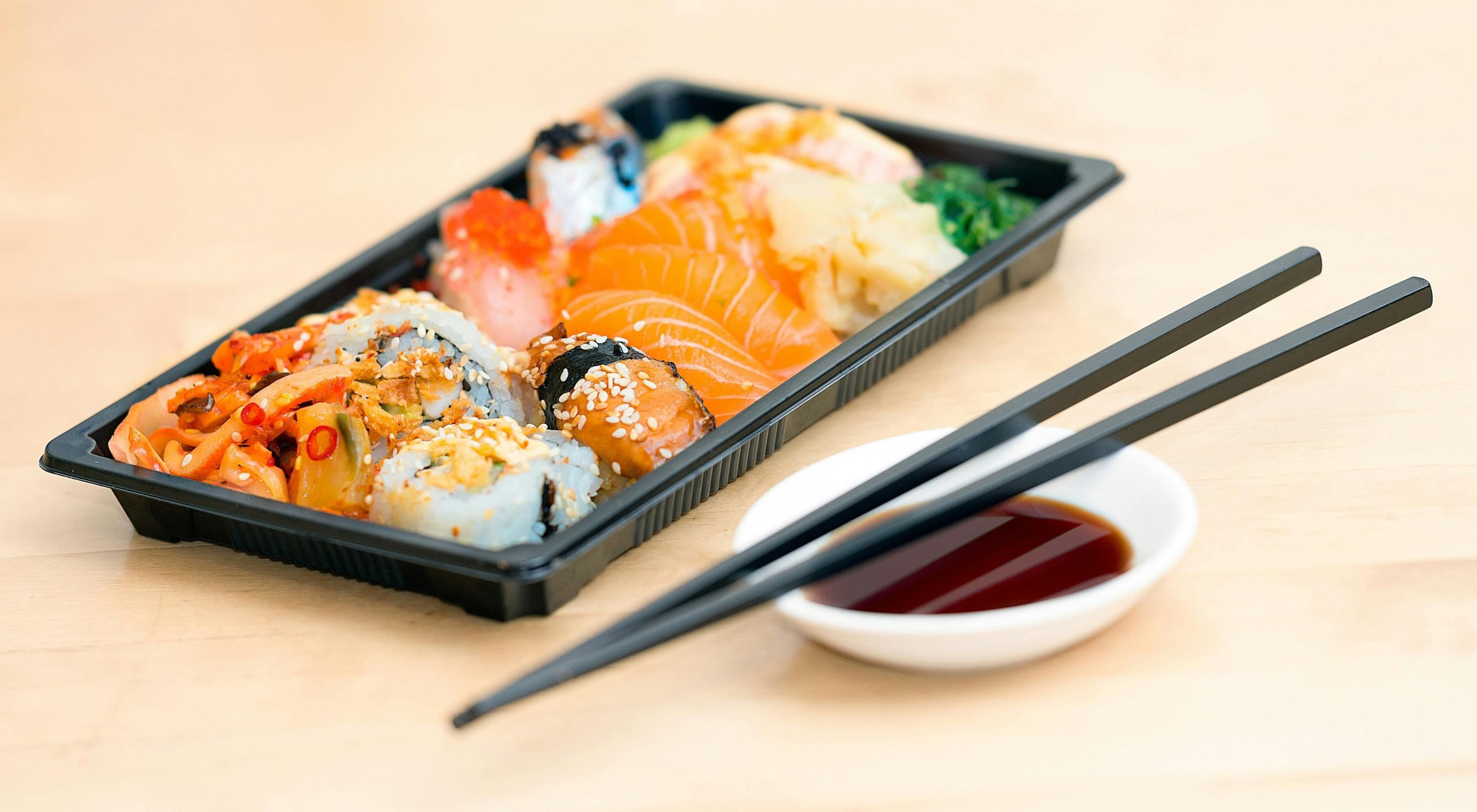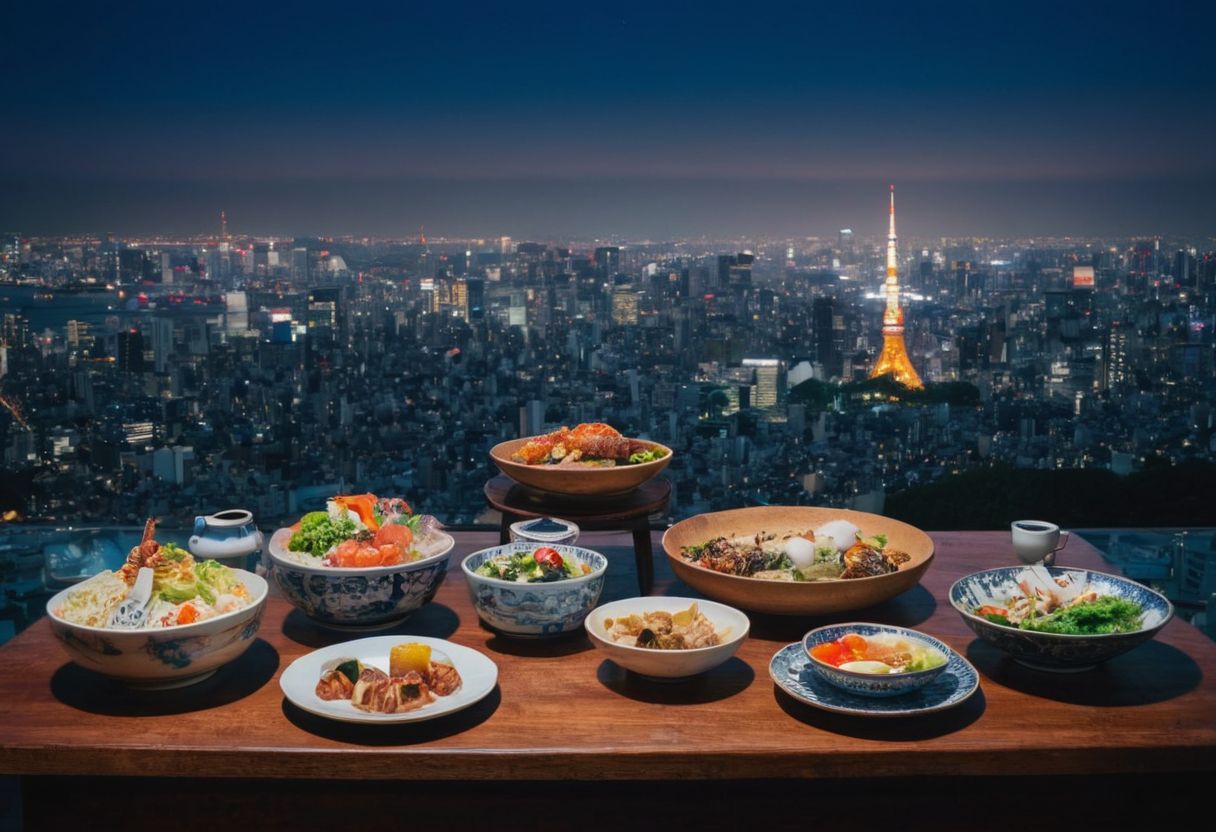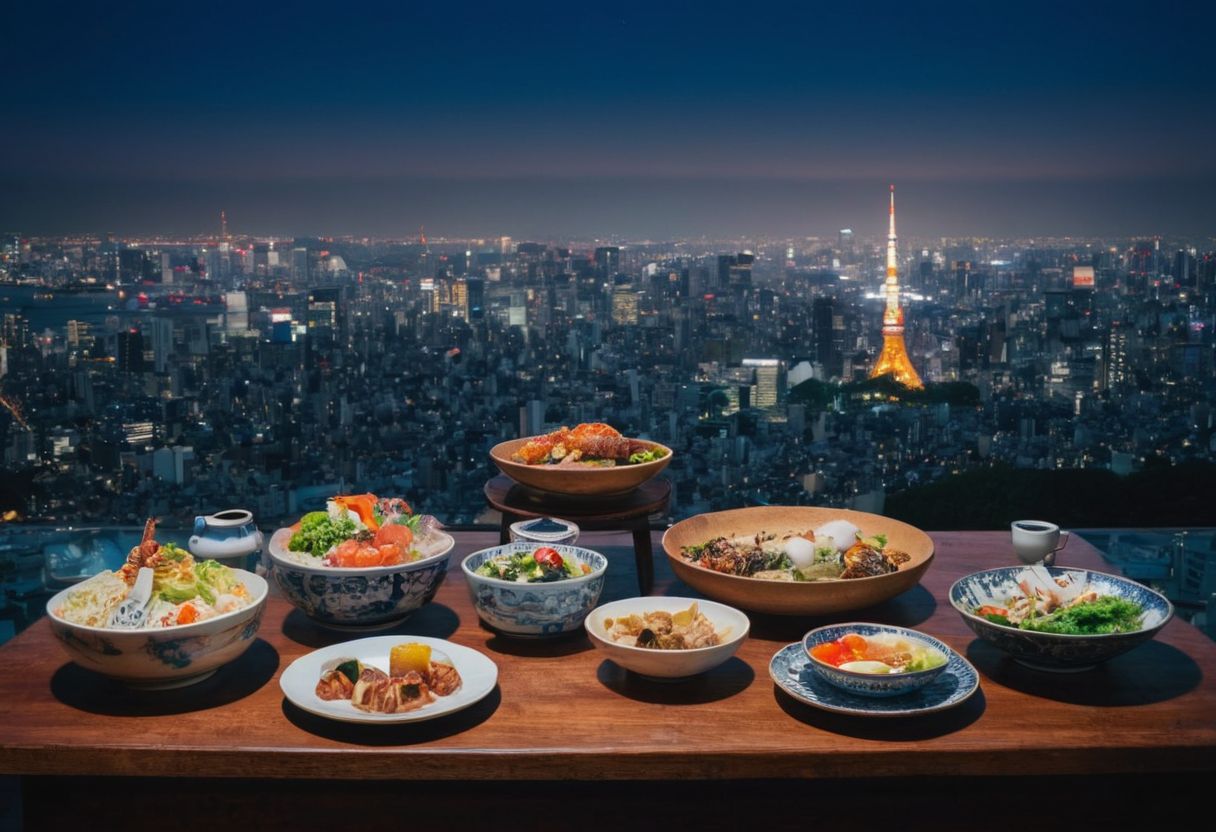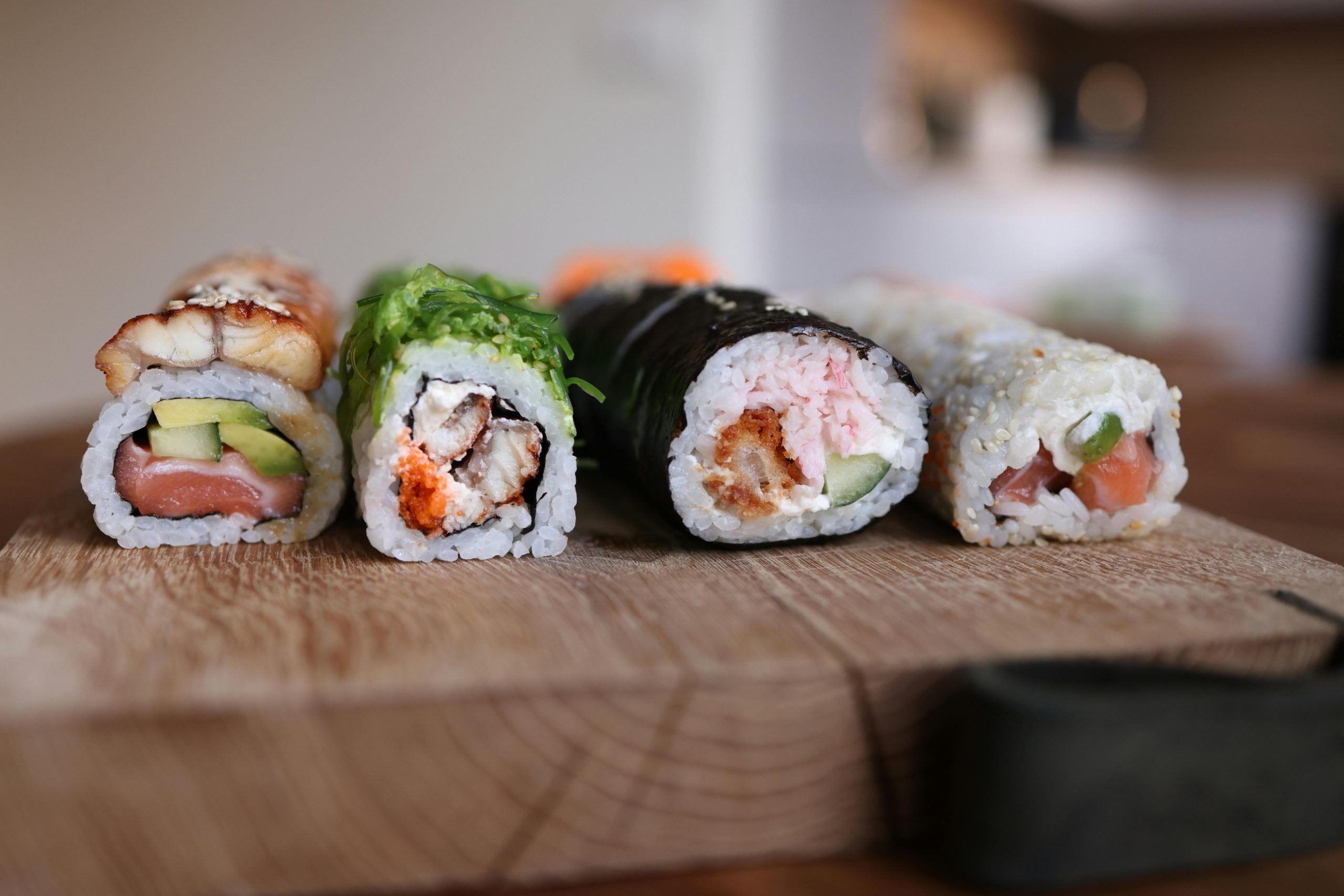Have you ever wondered what makes Kyoto cuisine so uniquely captivating?
Finding authentic and traditional Japanese cuisine can be a daunting task amidst the plethora of dining options available.
Kyoto Japanese cuisine is renowned for its refinement, emphasis on seasonal ingredients, and traditional styles such as Kaiseki, which is an artful multi-course meal deeply rooted in the local culture and history.
In this blog post, we’ll take you on a culinary journey through Kyoto, exploring the traditional Kaiseki, the comforting Obanzai Ryori, spiritual Shojin Ryori, and much more, to understand the depth and variety of Kyoto’s gastronomic offerings.
Kaiseki: The Art of Japanese Fine Dining

Kaiseki, the quintessence of Japanese haute cuisine, is an intricate multi-course meal that mirrors the seasonal transitions and artistic heritage of Kyoto. Each dish in a Kaiseki meal is not only a feast for the taste buds but also for the eyes, meticulously arranged to showcase the natural beauty and freshness of the ingredients.
This traditional dining experience involves a sequence of dishes, each crafted to harmonize flavors and textures. The courses are served in a specific order, designed to take diners on a culinary journey through the distinct flavors of each season, making every Kaiseki meal a unique reflection of the time of year.
Ingredients: The Foundation of Kyoto Cuisine

The foundation of Kyoto’s Kaiseki cuisine lies in its use of seasonally fresh and local ingredients, known as ‘shun-no-mono’. These ingredients are selected for their peak flavor and texture, ensuring that each dish reflects the essence of the season. Key items include Kyoto vegetables (Kyo-yasai), such as mizuna and kujo negi, and other regional specialties like tofu and yuba, which are celebrated for their quality and taste.
The meticulous selection of ingredients is crucial for authentic Kyoto cuisine, which emphasizes natural flavors and minimalistic cooking techniques. Here are a few staples:
- Tofu and Yuba: Silken textures that absorb the subtle flavors of broths and seasonings.
- Kyo-yasai (Kyoto vegetables): Unique varieties that offer more intense flavors and nutritional benefits.
- Seasonal fish and seafood: Sourced to ensure freshness and sustainability, aligning with Kyoto’s culinary philosophy.
Obanzai Ryori: Home Cooking in Kyoto

Obanzai Ryori is a cherished style of home cooking in Kyoto, reflecting the simplicity and seasonality of local ingredients. This cooking tradition involves preparing multiple small dishes that bring out the natural flavours of the ingredients without complex techniques. It’s not just about taste; it’s about creating a comforting, nutritious meal that feels like home.
The key characteristics of Obanzai Ryori include:
- Use of local, seasonal produce: Ingredients are often sourced from nearby fields, ensuring freshness and supporting local farmers.
- Simple preparation methods: These help maintain the original taste and nutritional value of the food.
- Economical and sustainable: Embracing the ‘mottainai’ philosophy, which means avoiding waste, many dishes utilize parts of ingredients that are typically discarded.
Shojin Ryori: Spiritual Vegetarian Cuisine

Shojin Ryori represents more than just a vegetarian meal; it is a spiritual practice deeply rooted in Zen Buddhism. This cuisine developed in the temples of Kyoto, reflecting the Buddhist precept of non-violence by excluding all animal products. The dishes are crafted to bring balance and harmony, both in flavour and in the eater’s mind. The meals consist of seasonal vegetables and tofu, presenting a variety of textures and subtle flavours that encourage mindfulness and appreciation of the food.
The preparation of Shojin Ryori is an art form that emphasises simplicity and thoughtfulness. Every ingredient is used thoughtfully, ensuring nothing goes to waste, embodying the Buddhist philosophy of mindfulness and respect for all living things. Some key components include:
- Seasonal vegetables: These are selected for their freshness and are often locally sourced.
- Tofu and legumes: Provide protein and texture, absorbing the delicate flavours of the dish.
- Seaweed and mushrooms: Add depth and umami to the meals.
This cuisine not only nourishes the body but also the spirit, making it a unique and essential experience in Kyoto.
Kawayuka: Riverside Dining in Kyoto
Kawayuka offers a unique dining experience in Kyoto, where restaurants set up temporary platforms over rivers during summer. This tradition allows diners to enjoy their meals while feeling the cool breeze and listening to the gentle flow of the river, adding a serene atmosphere to the dining experience.
The beauty of Kawayuka is not just in its setting but also in the variety of cuisines available. From traditional Japanese dishes to international flavors, these riverside platforms cater to all tastes. Diners can expect:
- Fresh local river fish
- Seasonal vegetables
- A selection of Japanese sake and other drinks
This blend of natural beauty and culinary delight makes Kawayuka a must-try experience in Kyoto.
Yu Do-fu: Kyoto’s Comforting Tofu Hot Pot
Yu Do-fu is a cherished dish in Kyoto, especially during the chillier months. This simple yet profound hot pot consists primarily of tofu simmered gently in a clear broth. The tofu used is typically silken, allowing it to absorb the subtle flavors of the kombu (kelp) and other delicate seasonings present in the broth. This dish exemplifies the Japanese culinary principle of highlighting the natural taste of the ingredients without overpowering them.
The enjoyment of Yu Do-fu is enhanced by its customary condiments, which diners can use according to their taste. These often include:
- Ponzu, a citrus-based soy sauce that adds a tangy touch.
- Grated ginger, providing a warm, spicy note.
- Green onions, finely chopped for a burst of freshness.
This combination allows each person to tailor the flavor of the tofu to their liking, making Yu Do-fu a personal and interactive eating experience, much like other Japanese hot pot dishes.
Sushi in Kyoto: A Blend of Tradition and Freshness
Sushi in Kyoto is celebrated for its distinctive flavors that blend traditional techniques with fresh, local ingredients. Unlike coastal cities, Kyoto’s sushi incorporates unique preservation methods, like those used in saba-zushi, where mackerel is marinated in vinegar.
The city’s dedication to seasonal ingredients means sushi menus change throughout the year, showcasing items like bamboo shoots in spring and puffer fish in winter. This commitment ensures every piece of sushi and sashimi offers a fresh and seasonal taste, truly reflecting Kyoto’s culinary heritage.
Tempura: Kyoto’s Crispy Delicacies
Tempura in Kyoto offers a delightful experience with its light and crispy texture. This dish, consisting of seafood or vegetables dipped in a delicate batter and deep-fried, is a favourite among both locals and tourists. The shrimp tempura stands out as a particularly popular choice, showcasing the freshness and flavour of local seafood.
The versatility of tempura extends beyond shrimp to include options like soft shell crab and a variety of vegetables, each bringing its unique taste and texture to the table. This method of cooking not only preserves the natural flavours but also adds a satisfying crunch, making tempura a must-try dish in Kyoto’s culinary landscape.
Noodles of Kyoto: Udon, Soba, and More
In the realm of Kyoto’s diverse culinary scene, noodles hold a special place with varieties like udon and soba standing out. Udon, made from thick wheat flour, offers a chewy texture that pairs beautifully with both mild and robust broths. On the other hand, soba, crafted from buckwheat, presents a more delicate and slightly nutty flavor, often served chilled with a dipping sauce or in a hot, soothing broth.
Each type of noodle is a testament to Kyoto’s culinary craftsmanship, reflecting the city’s appreciation for texture and flavor. Here are some highlights:
- Udon: Known for its thick, slurp-worthy strands.
- Soba: Appreciated for its earthy tone and versatility.
Whether tucked into a warming soup during the chilly months or enjoyed cold with a dash of soy-based sauce in the summer, these noodles offer a delightful gastronomic experience unique to Kyoto.
Sukiyaki: Kyoto’s Savory Hot Pot Experience
Sukiyaki stands as a celebrated hot pot dish in Kyoto, beloved for its rich and savory flavors. This dish artfully combines thinly sliced beef, tofu, and a medley of vegetables, all simmered together in a sweet and savory sauce known as ‘warishita’. The communal nature of sukiyaki makes it a popular choice for gatherings, allowing everyone to cook and share the meal directly from the pot placed at the center of the table.
The preparation of sukiyaki involves layering ingredients in a specific order to maximize the absorption of flavors. Key components typically include:
- Beef: Very thinly sliced to ensure it cooks quickly and absorbs the sauce.
- Vegetables: Such as shiitake mushrooms, spring onions, and sometimes other seasonal greens.
- Tofu: Added towards the end to soak up the broth without breaking apart. Each element contributes to the depth of flavor and texture, making sukiyaki a deeply satisfying part of Kyoto’s culinary tradition.
Shabu-shabu: Kyoto’s Interactive Dining
Shabu-shabu is a delightful interactive dining experience, cherished in Kyoto for its simplicity and communal enjoyment. This hot pot dish involves diners cooking thinly sliced meat by swishing it back and forth in a pot of steaming broth. The name ‘shabu-shabu’ directly translates to ‘swish-swish’, describing the action of cooking the meat, which takes just a few seconds per slice, ensuring it remains tender and succulent.
The broth used in shabu-shabu is typically a simple dashi, flavoured subtly with kombu to enhance but not overpower the natural flavours of the meat and vegetables. Diners can enjoy a variety of dipping sauces, such as sesame or ponzu, to complement the cooked meat and vegetables. This method not only makes the dining experience fun and interactive but also allows each person to customise their meal to their own taste preferences.
Japanese Sake: Kyoto’s Traditional Rice Wine
Japanese Sake, or nihonshu, is a traditional rice wine that has been an integral part of Kyoto’s culinary landscape for centuries. The brewing of sake in Kyoto is distinguished by its reliance on local ingredients, particularly the water sourced from the Fushimi area, renowned for its purity and mineral richness. This water, combined with locally grown rice varieties such as Yamada Nishiki and Gohyakumangoku, known for their high starch content, forms the backbone of Kyoto’s sake brewing.
The traditional kimoto method, used by many Kyoto breweries, involves a meticulous process where naturally occurring lactic acid bacteria are nurtured to create the starter mash. This method, though time-consuming, imparts a complex and deeper flavor profile to the sake, making it a sought-after beverage for both casual enjoyment and ceremonial purposes. The unique characteristics of Kyoto’s sake not only offer a taste of the region’s rich heritage but also highlight the skilled craftsmanship behind each bottle.
Discover More with Culinary Tours
After indulging in the diverse flavours of Kyoto Japanese cuisine, why not explore further with curated culinary tours? INDULGE offers a variety of tours that delve deep into both local and international cuisines, providing a unique opportunity to experience authentic Japanese dishes alongside other global flavours. These tours are perfect for anyone eager to expand their culinary horizons and appreciate the intricate tastes and traditions of Kyoto’s gastronomy.
Frequently Asked Questions
What foods is Kyoto famous for?
Kyoto is celebrated for its diverse and traditional Japanese cuisine, which includes Kaiseki, Obanzai Ryori, Shojin Ryori, Kawayuka, Yu Do-fu, sushi, tempura, various noodles like udon and soba, Sukiyaki, Shabu-shabu, and Japanese sake. These dishes emphasise local, seasonal ingredients and traditional cooking methods, showcasing Kyoto’s rich culinary heritage.
Why is tofu famous in Kyoto?
Tofu is famous in Kyoto for its quality and taste, particularly in dishes like Yu Do-fu. The region’s tofu is known for its silken texture, which excellently absorbs the subtle flavours of broths and seasonings, making it a staple in both traditional and everyday Kyoto cuisine.








